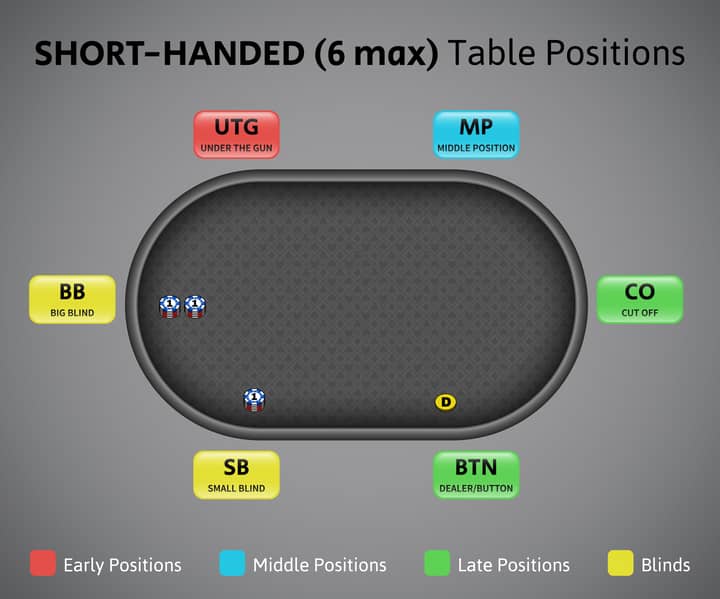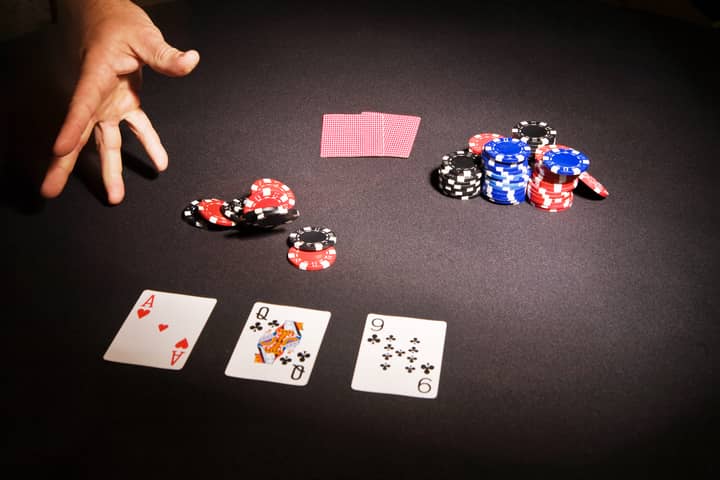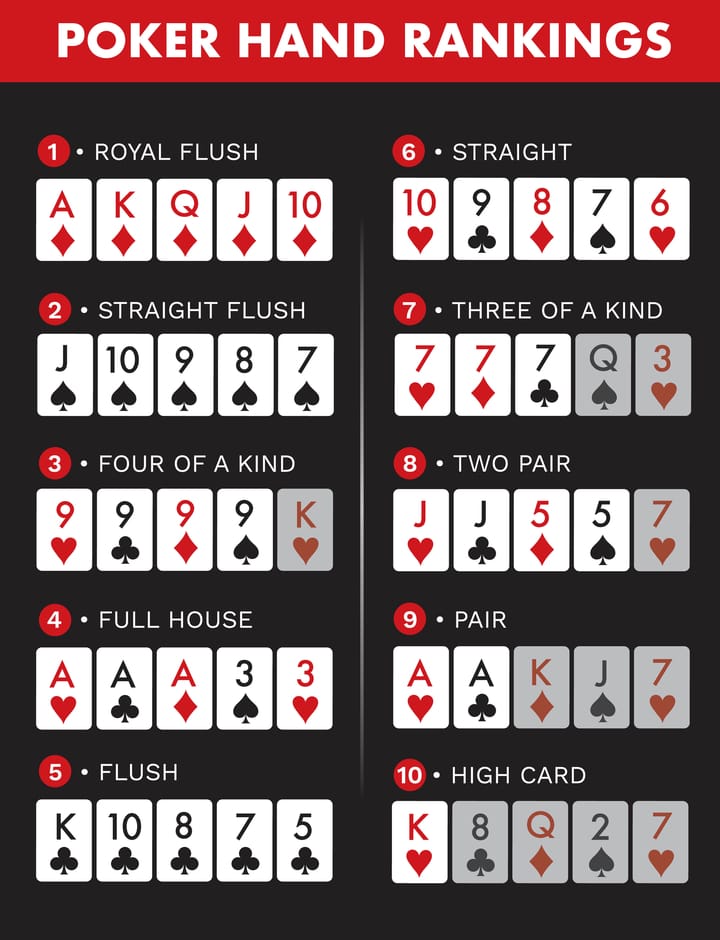Texas Holdem Rules – How to Play Texas Hold’em Poker and Win
Sometimes referred to as the Cadillac of poker, Texas Hold’em is by far the most popular poker game these days.
It has been one of the more popular variants of the game featured in many tournaments and various poker movies alike, but the big Moneymaker WSOP win in 2003 propelled the game to new heights.
While not too complicated, Texas Holdem rules require you to learn quite a few things to start winning at the tables.
This is why I decided to break down the game’s basic rules and teach you how to play Texas Holdem so you can dominate your home games and beat your friends.
This guide will break down everything you need to know, from the basic rules of Texas Holdem and hand rankings to different betting streets and your position’s importance.
Just remember to take things slow and don’t play with experienced opponents before you get your feet wet against your friends.
Basic Texas Holdem Rules – Know What Matters

Before we get into any specifics, I want to explain how Texas Hold’em is played in the first place. If you have ever played any form of poker at all, you may already understand these basics, but let’s cover them anyway.
The object of the game is to make the best five-card hand according to poker hand rankings or make all of your opponents fold their cards.
We will break down every single step in this article, but before diving deep into that, I want to give you a quick breakdown of how each Texas Hold’em hand starts:
- Players post forced bets known as the blinds
- Every player is dealt two cards face down, known as hole cards
- The first betting round begins, which is followed by three community cards being dealt face-up in the middle of the table
- The second betting round is followed by one additional card dealt in the middle
- Third betting round followed by the last card dealt in the middle
- The final betting round and the showdown.
Each player uses only five cards to make the best possible poker combination and can pick whichever works best for him between his holdings and community cards.
Between these cards, players get four betting rounds.
During these rounds, players can make bets and try to get other players to fold their cards or to call the bets with weaker holdings.
It is important to note that every player in the hand can get rid of his hole cards (fold) at any time during the hand, thus eliminating him from the hand and taking away his chances to win it.
All that said, let us walk through a hand of a Texas Hold’em game and explain the rules of Texas Hold’em one betting street at a time.
Texas Holdem Hands – How to Play Texas Hold’em Poker

As I already explained, each Texas Hold’em hand consists of multiple betting streets and several community cards dealt in the middle of the table for everyone to use.
The final objective is to win the hand with the best hand combination or remain the only player in the hand.
This still probably doesn’t explain enough about how the game is played, so let’s get into some more details and walk you through a hand of Texas Hold’em one step at a time.
Pre-Flop: The Forced Bets and Initial Betting Round
Every Texas Holdem poker hand starts with two players at the table putting in forced bets. These bets are known as the “small blind” and the “big blind” and are made before dealing the cards.

In the beginning, the dealer randomly assigns a dealer button to one player at the table, and then it moves clockwise every hand.
The two players to the left of the dealer button post the small blind and the big blind accordingly, which is used to induce action.
- These forced bets are predefined and don’t change in a cash game.
- In a tournament, the forced bets increase in size as the tournament progresses and players are eliminated.
Once the blinds are posted, the game can start.
The dealer deals the two hole cards to each player at the table, starting with the small blind player and ending with the player on the dealer button.

When all the cards are dealt, the player to the left of the big blind (“under the gun”) has the first action.
This player can:
- FOLD – meaning he is getting rid of his cards and not playing this hand anymore.
- CALL – meaning he put the same about as was bet before, in this case, equal to the big blind.
- RAISE – increase the size of the bet.
The raise size is usually unlimited unless you are playing pot limit or limit Hold’em, which I will go into a bit later.
For now, simply assume we are playing a no-limit game, which is the most frequent one.
After the first player finishes his action, each remaining player has the same options. If one player raises the bet, other players must match that bet to stay in the hand or make another raise.
If a player raises all their chips, they are pronounced as “all in.” In this case, the player’s cards can no longer be folded.
The last player to get action is the player in the big blind.
If there was a raise, the player could choose to call this raise, raise further, or fold his cards. If there was no raise, the player could also choose to check, ending the round and seeing the first community cards.
The more hands you play preflop, the higher your VPIP poker stat will be, which can signal that you might be playing too often, and other players can start attacking you because of that.
The pre-flop action ends when all the players have acted, and all the bets have been settled.
The remaining players, who have called the size of the active bet, now go to the next round, which is the flop.
The Flop: First Community Cards
The dealer deals out three community cards in the middle of the table. These three cards are called “the flop,” and all players in the Texas Holdem hand get to use them to create their combination.
The flop is the first moment in which players actually have a full poker hand to speak of, as a total of five cards are now available to each player.

Now that the flop is dealt, each of the remaining players can once again bet.
Each player can decide to check their option, meaning they don’t bet anything and give action to the next player.
They can also decide to bet into the pot.
According to no-limit Texas Hold’em rules, the player can bet any amount he wants, as long as that amount is not greater than the stack of chips the player has on the table.
Players again take turns betting, calling bets, and raising, starting from the left of the dealer button. The player who holds the dealer button always acts last on the flop, turn, and river.
Once all the players have completed their flop actions, the dealer will collect all the chips into the pot and deal out the next community card.
The Turn: Action Continues
The dealer now deals a single community card in the middle of the table.
This community card is called “the turn,” and it can now actively participate in the players’ poker hands.
The turn is the card that often changes players’ hands in meaningful ways, and the betting round that ensues can be full of surprises.
Once again, just like on the flop, all players who are still in the hand get to take turns:
- checking
- betting
- calling
- or folding their cards
The player order is the same as it is on the flop, starting with the players to the dealer button’s left and moving clockwise.
Note that there usually aren’t too many players remaining in the hand by the turn.
Every player gets to take action, and the round is completed when all players have made their bets, and they have been settled, or all players but one have folded their cards.
The River: Final Betting Round
The river is the final card in the Texas Hold’em game. Once again, the dealer deals out a single card face-up on the table, and this is the final community card.
All the remaining players in the hand now have seven different cards they can use to make their poker hand.
Once again, betting ensues.
Players bet in the same order as they did on the flop and the turn.
Each player gets a turn and can choose to check or bet if not facing a bet already, or call, raise, or fold if facing a bet.
Once all players have made their bets and decided whether their cards are worth staying in the hand, the hand will end. If a single player has remained, that player will win the pot. Otherwise, the dealer will announce a showdown.
The Showdown: Comparing the Hand
Now it is time to compare Texas Holdem hands and see who wins.
If two or more players are still in the hand, the dealer announces a showdown, compelling players to show their hole cards.

If there was no betting action on the river, the first player left of the dealer button shows his hand, and then this moves clockwise.
If there was betting on the river, the last player who made aggressive action (bet or raise), will show his cards first.
As players show cards, others at the table get to show theirs in order or simply throw their cards away when they see they are beaten.
An exception to this is in tournaments, where players can be compelled to show their cards, regardless of their position, to prevent players from colluding and throwing away better hands to their friends.
When cards are shown, the dealer makes a decision on which hand is the winner.
This is done in accordance with Texas Hold’em hand rankings, which do not change under any circumstances.
So what hand is the winner? If you still don’t know, let’s get into the poker hand rankings and explain which hands beat which and how they are formed.
Texas Holdem Hands Rankings
If you are new to the game of poker or Texas Hold’em specifically, you probably don’t know what hand beats what or even what hands are available.

For that reason, let us quickly go through the poker hands you can make and how they compare to one another from strongest to the weakest.
- Royal Flush: An extremely rare hand that consists of the five highest-ranked cards of the same suit. This hand cannot be beaten, and if you hold it, your only concern will be how to get your opponents to pay up.
- Straight Flush: Five consecutive cards of the same suit make a straight flush. A straight flush can be beaten by a stronger straight flush or a royal flush.
- Four of a Kind: Holding four cards of the same rank is called four of a kind (or sometimes quads). Four of a kind is nearly unbeatable and almost always the winner.
- Full House: Three of a kind + a pair makes a full house. An example would be A A A K K. This is one of the most powerful poker hands out there and one that often wins huge pots.
- Flush: Five cards of the same suit make a flush. Flushes are very powerful, and multiple flushes can exist in the same hand. If this is the case, the one with the highest card is the winner.
- Straight: Five consecutive rank cards make a straight. An example would be 5 6 7 8 9. If these cards are of a different suit, the hand is called a straight and beats all hands that rank below it.
- Three of a Kind: Also known as set or trips, three of a kind is a hand you make by having three cards of the same rank. Three of a kind beats two pair and can be an extremely strong hand when two hole cards pair up with one from the board.
- Two Pair: Holding two pairs of cards of the same rank is called two pair. If you hold two pair hand, the highest other card is used as your “kicker” and can be used to beat opponents who hold the same two pair.
- One Pair: If two of your five cards are of the same rank, you will have one pair. The highest card apart from that pair will be considered your “kicker” and can be used to beat your opponents if you hold the same one pair.
- High Card: If all five of your cards are of different rank, your hand will be ranked according to the highest card you hold. For instance, A K J 8 5 is an ace high, which beats king high, etc.
Know you know what beats what in Texas Holdem, so we can move to another crucial concept and cover the importance of position in this game.
Understanding Position and Why It Matters
Novice players who have only just learned the Texas Hold’em rules don’t realize the importance of position in the game, but it is probably the most important thing to learn before you start playing.
So why is position so important?
Because position determines who will act first and last on each street once the flop is dealt.
This may not seem like such a huge deal, but it’s actually critical and if you are playing online, make sure to use tools such as Poker Tracker 4, to understand this part to the fullest.
Depending on the number of players at the table, there can be as few as two and as many as ten positions in each Texas Hold’em hand.
These days, the most standardized games include either nine or six players, with nine being more standard for tournaments and six for cash games.

I am going to give you some idea of the positions you can find yourself in and how they differ in terms of the strategy you should apply:
- Early Position: The positions just to the left of the blinds. Many players will act after you, so you should pick your hands carefully. You will act first against any later position players on later streets, so be careful.
- Middle Position: Things are getting slightly better now. You will have a position against any early position callers or raisers. Still, the late position players will act last, so choose your hands wisely.
- Late Position: These positions are the best to be in, and you can widen up your starting hands in them. You will always act on later streets if you have the button, so make sure to use that to your advantage.
- The Blinds: You already have money invested into the pot, but you will play out the hand out of position. Be careful when choosing hands to play as your opponents will have a great advantage.
The positional advantage in Texas Hold’em is not an easy lesson, but it’s one that starts with one simple premise.
The weaker your position, the stronger hands you should be looking to play from it, and wise vera.
The dealer button is the absolute best position in Texas Hold’em and one that can be used to steal the blinds by raising many times, even with marginal holdings.
On the other hand, the blind positions will always play first after the flop is dealt, meaning they will never get that extra information on how their opponents have acted.
You can learn more about the positional play by reading these poker tips, but for a start, just remember that position is very important, and always keep it in mind when deciding which hands to play.
Rules Of Texas Holdem: When to Bet and Why

You are almost ready to get into your first Texas Hold’em game, but there is one more thing you need to learn, and that is how and when you should make bets.
There are two main reasons to bet in poker in general.
- The first one is to get your opponents to put money into the pot when you have a great hand.
- The other is to make them fold cards better than yours.
The first reason, called value betting, is the essence of poker. When you have a big hand like pocket aces, you want to make bets and try to get paid.
Value betting starts before the flop when hands are still not completed.
When you hold strong hands like AA, KK, or AK, you will want to raise to get your opponents to start paying you off.
A raise to 3x the big blind is standard in most games, and as a novice, I would suggest you start with this size and change it up as you learn more about the game.
After the flop, remember to make your bets in relation to the pot size.
Make your bets enticing for players to call with worse hands but not enticing enough to make a drawing hand worth their while.
This way, you will avoid many unpleasant situations like getting pot committed too often or losing against ridiculous hands.
On the other hand, if you are bluffing with a hand like a draw or no pair, you will want your opponents to fold their cards.
Remember that you must not make your bets too transparent and should always make it look like you are betting for value in Texas Holdem. This way, your opponents will never know if you have it or not.
Texas Holdem Cash Games vs. Tournaments

If you have ever played Texas Hold’em before, you are probably aware that there are two basic formats in which the game is played, and these are cash games and tournaments.
The differences between cash games and tournaments in the Texas Hold’em game are quite few.
The most basic one is the way chips are distributed to the players at the start.
- In a cash game, the house sets the blinds and the minimum/maximum buy-in.
- When players buy-in, they are issued chips to the tune of the monetary amount they purchased.
For example, if you join a local $1/2 game and buy-in for $200, you will receive $200 in chips, with denominations such as $2 and $5 on the chips.
The blinds in a cash game do not change (unless players decide to), and each hand is played at the same blinds as the previous one.
In a Texas Hold’em tournament, players are all asked to pay a buy-in fee, which differs from one tournament to the next.
For that money, they are issued a starting stack of chips, which also differs. For example, a $100 tournament might start with every player getting $20.000 in chips.
These tournament chips have no monetary value and cannot be cashed out.
Instead, players play out the tournament until only one player remains, winning it all.
- The blinds in a tournament will go up in time increments, thus forcing players to be eliminated over time.
- A percentage of the players (10 or 15%) will receive a part of the overall prize pool that was created from all the buy-ins.
Both cash games and tournaments are very entertaining to play, but they require completely different strategies and approaches.
You might want to check a list of the best poker players to see what they prefer to play, and then make up your mind which of the formats you will test first!
- Heartland Poker Tour – Will HPT Ever Come Back - October 20, 2022
- Top 6 Pros of Playing Slots Online - October 13, 2022
- Sammy Farha Net Worth – How Wealthy Is the Poker Icon? - October 13, 2022





